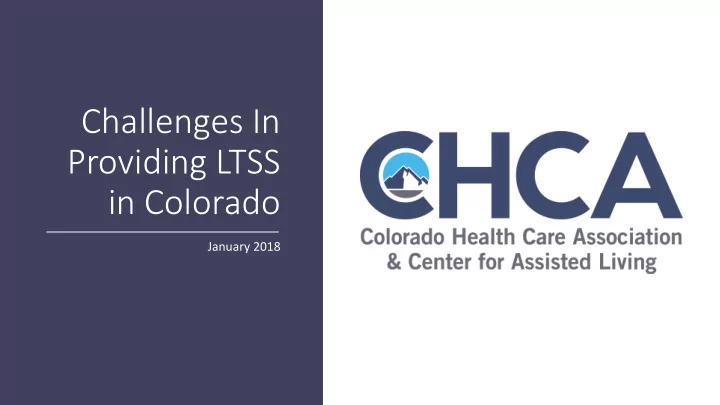

Challenges In Providing LTSS in Colorado January 2018
• The Colorado Health Care Association and Center for Assisted Living provides education, information and advocacy for nursing home and assisted living communities in Colorado • Our Membership includes 85% of the State’s Who We Are nursing homes and about 15% of the State’s assisted living communities. • On an average day, our membership includes more than 25,000 employees providing care for more than 18,500 elderly and disabled Coloradoans.
• There are 235 nursing homes in Colorado with more than 21,000 beds of care • There are 671 licensed assisted living LTC In communities in Colorado with just over 20,000 beds Colorado • Occupancy hovers around 80% • Increased focus on Post Acute Care • Stand Alone & SNF Based
Resident Profiles: • Nursing Homes: • Average Age is 78 Years • Average ADL Dependence is 4.6 LTC In • Percent with Dementia is 61% • % That Discharge to Community is 65.2% Colorado • Assisted Living: • 46% are Over Age 85 • Average ADL Dependence is 2.5 • Percent with Dementia is 41% • After average stay of 22 Months, 60% transition to skilled nursing
Nursing Homes • More than 70% of nursing home care is being paid for by Medicaid or Medicare • Colorado has a unique funding mechanism known as Pay for Performance • Provides a financial incentive for achieving certain quality outcomes Financing • Colorado is in the top tier nationally in terms of quality metrics • The Pay for Performance structure is something other states are trying to emulate • Despite our favorable reimbursement arrangement, providers still lose more than $9 per resident, per day under Medicaid • MedPAC studies indicate that skilled nursing facilities operate on a .7% profit margin considering all funding sources
Assisted Living • The majority of assisted living is private pay • The Medicaid program does pay for certain assisted living services, but the number of Medicaid residents in Financing assisted living represents a very small percentage of overall care (19% Nationally) • For the most part, assisted living is a viable option for those with higher than average financial means.
• Regulation Challenges • Financing Ahead • Adequate Human Capital
• Skilled Nursing is the most regulated profession in America • Assisted Living has continued to grow rapidly, and regulation is beginning to catch up (especially as acuity increases) • Increasing regulation leads to time constraints Regulation within each building • Understanding that buildings operate on small profit margins means that new regulation detracts from direct caregiving in order to satisfy paper compliance • Regulation needs to be aimed at quality outcomes rather than work inputs
• In both skilled nursing and assisted living environments, the stability of financing moving forward will determine availability of care options • National and state level pressures to cut Medicaid costs Financing • The boom generation has high expectations for care options in retirement years, but studies show that savings are inadequate to meet their expectations. • Private Managed Care Companies continue to push cost saving measures. Managed LTC has been disastrous in other states.
• The provision of skilled nursing and assisted living is labor intensive • Entry level employees are in high demand, and even with increased pay, remains difficult to hire for front line positions • With unemployment hovering around 3% its is terribly difficult to find solid employees • Providers can’t just take any willing employee…they have to be well-suited to caregiving Human Capital • Demographic shifts are going to increase the number of 65+ residents disproportionately to the younger population. Most of the in-migration to Colorado is in the professional class…not entry level • Affordable housing is a significant issue in attracting entry level employees in especially high-cost areas along the front range • While increasing the number of care options is a positive, it does further stretch the health care workforce
Doug Farmer President & CEO/ Colorado Health Care Association Contact Dfarmer@cohca.org 303-861-8228
Recommend
More recommend